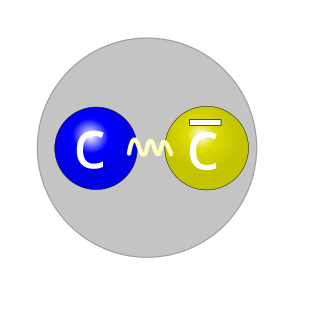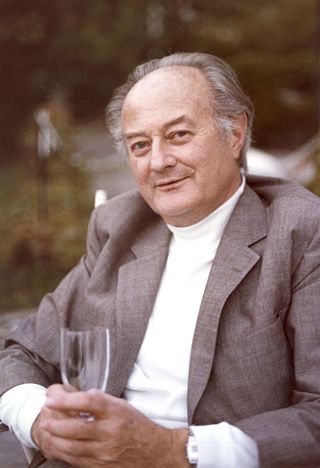Related Research Articles

A gluon is an elementary particle that acts as the exchange particle for the strong force between quarks. It is analogous to the exchange of photons in the electromagnetic force between two charged particles. Gluons bind quarks together, forming hadrons such as protons and neutrons.

A quark is a type of elementary particle and a fundamental constituent of matter. Quarks combine to form composite particles called hadrons, the most stable of which are protons and neutrons, the components of atomic nuclei. All commonly observable matter is composed of up quarks, down quarks and electrons. Owing to a phenomenon known as color confinement, quarks are never found in isolation; they can be found only within hadrons, which include baryons and mesons, or in quark–gluon plasmas. For this reason, much of what is known about quarks has been drawn from observations of hadrons.

In theoretical physics, quantum chromodynamics (QCD) is the theory of the strong interaction between quarks mediated by gluons. Quarks are fundamental particles that make up composite hadrons such as the proton, neutron and pion. QCD is a type of quantum field theory called a non-abelian gauge theory, with symmetry group SU(3). The QCD analog of electric charge is a property called color. Gluons are the force carriers of the theory, just as photons are for the electromagnetic force in quantum electrodynamics. The theory is an important part of the Standard Model of particle physics. A large body of experimental evidence for QCD has been gathered over the years.

The
J/ψ
(J/psi) meson is a subatomic particle, a flavor-neutral meson consisting of a charm quark and a charm antiquark. Mesons formed by a bound state of a charm quark and a charm anti-quark are generally known as "charmonium" or psions. The
J/ψ
is the most common form of charmonium, due to its spin of 1 and its low rest mass. The
J/ψ
has a rest mass of 3.0969 GeV/c2, just above that of the
η
c, and a mean lifetime of 7.2×10−21 s. This lifetime was about a thousand times longer than expected.
Quark matter or QCD matter refers to any of a number of hypothetical phases of matter whose degrees of freedom include quarks and gluons, of which the prominent example is quark-gluon plasma. Several series of conferences in 2019, 2020, and 2021 were devoted to this topic.

A jet is a narrow cone of hadrons and other particles produced by the hadronization of a quark or gluon in a particle physics or heavy ion experiment. Particles carrying a color charge, such as quarks, cannot exist in free form because of quantum chromodynamics (QCD) confinement which only allows for colorless states. When an object containing color charge fragments, each fragment carries away some of the color charge. In order to obey confinement, these fragments create other colored objects around them to form colorless objects. The ensemble of these objects is called a jet, since the fragments all tend to travel in the same direction, forming a narrow "jet" of particles. Jets are measured in particle detectors and studied in order to determine the properties of the original quarks.
In particle physics, the Lund string model is a phenomenological model of hadronization. It treats all but the highest-energy gluons as field lines, which are attracted to each other due to the gluon self-interaction and so form a narrow tube of strong color field. Compared to electric or magnetic field lines, which are spread out because the carrier of the electromagnetic force, the photon, does not interact with itself.

In particle physics, a three-jet event is an event with many particles in final state that appear to be clustered in three jets. A single jet consists of particles that fly off in roughly the same direction. One can draw three cones from the interaction point, corresponding to the jets, and most particles created in the reaction will appear to belong to one of these cones. These events are currently the most direct available evidence for the existence of gluons, and were first observed by the TASSO experiment at the PETRA accelerator at the DESY laboratory.
In particle physics, the parton model is a model of hadrons, such as protons and neutrons, proposed by Richard Feynman. It is useful for interpreting the cascades of radiation produced from quantum chromodynamics (QCD) processes and interactions in high-energy particle collisions.
In particle physics phenomenology, chiral color is a speculative model which extends quantum chromodynamics (QCD), the generally accepted theory for the strong interactions of quarks. QCD is a gauge field theory based on a gauge group known as color SU(3)C with an octet of colored gluons acting as the force carriers between a triplet of colored quarks.
R is the ratio of the hadronic cross section to the muon cross section in electron–positron collisions:

Rolf Hagedorn was a German theoretical physicist who worked at CERN. He is known for the idea that hadronic matter has a "melting point". The Hagedorn temperature is named in his honor.

Quark–gluon plasma is an interacting localized assembly of quarks and gluons at thermal and chemical (abundance) equilibrium. The word plasma signals that free color charges are allowed. In a 1987 summary, Léon van Hove pointed out the equivalence of the three terms: quark gluon plasma, quark matter and a new state of matter. Since the temperature is above the Hagedorn temperature—and thus above the scale of light u,d-quark mass—the pressure exhibits the relativistic Stefan-Boltzmann format governed by temperature to the fourth power and many practically massless quark and gluon constituents. It can be said that QGP emerges to be the new phase of strongly interacting matter which manifests its physical properties in terms of nearly free dynamics of practically massless gluons and quarks. Both quarks and gluons must be present in conditions near chemical (yield) equilibrium with their colour charge open for a new state of matter to be referred to as QGP.
In physics, vector meson dominance (VMD) was a model developed by J. J. Sakurai in the 1960s before the introduction of quantum chromodynamics to describe interactions between energetic photons and hadronic matter.

Johann Rafelski is a German-American theoretical physicist. He is a professor of Physics at The University of Arizona in Tucson, guest scientist at CERN (Geneva), and has been LMU-Excellent Guest Professor at the Ludwig Maximilian University of Munich in Munich, Germany.
In high-energy nuclear physics, strangeness production in relativistic heavy-ion collisions is a signature and diagnostic tool of quark–gluon plasma (QGP) formation and properties. Unlike up and down quarks, from which everyday matter is made, heavier quark flavors such as strange and charm typically approach chemical equilibrium in a dynamic evolution process. QGP is an interacting localized assembly of quarks and gluons at thermal (kinetic) and not necessarily chemical (abundance) equilibrium. The word plasma signals that color charged particles are able to move in the volume occupied by the plasma. The abundance of strange quarks is formed in pair-production processes in collisions between constituents of the plasma, creating the chemical abundance equilibrium. The dominant mechanism of production involves gluons only present when matter has become a quark–gluon plasma. When quark–gluon plasma disassembles into hadrons in a breakup process, the high availability of strange antiquarks helps to produce antimatter containing multiple strange quarks, which is otherwise rarely made. Similar considerations are at present made for the heavier charm flavor, which is made at the beginning of the collision process in the first interactions and is only abundant in the high-energy environments of CERN's Large Hadron Collider.
The photon structure function, in quantum field theory, describes the quark content of the photon. While the photon is a massless boson, through certain processes its energy can be converted into the mass of massive fermions. The function is defined by the process e + γ → e + hadrons. It is uniquely characterized by the linear increase in the logarithm of the electronic momentum transfer logQ2 and by the approximately linear rise in x, the fraction of the quark momenta within the photon. These characteristics are borne out by the experimental analyses of the photon structure function.

In theoretical particle physics, the gluon field is a four-vector field characterizing the propagation of gluons in the strong interaction between quarks. It plays the same role in quantum chromodynamics as the electromagnetic four-potential in quantum electrodynamics – the gluon field constructs the gluon field strength tensor.

The light-front quantization of quantum field theories provides a useful alternative to ordinary equal-time quantization. In particular, it can lead to a relativistic description of bound systems in terms of quantum-mechanical wave functions. The quantization is based on the choice of light-front coordinates, where plays the role of time and the corresponding spatial coordinate is . Here, is the ordinary time, is a Cartesian coordinate, and is the speed of light. The other two Cartesian coordinates, and , are untouched and often called transverse or perpendicular, denoted by symbols of the type . The choice of the frame of reference where the time and -axis are defined can be left unspecified in an exactly soluble relativistic theory, but in practical calculations some choices may be more suitable than others. The basic formalism is discussed elsewhere.

Stephan Narison is a Malagasy theoretical high-energy physicist specialized in quantum chromodynamics (QCD), the gauge theory of strong interactions. He is the founder of the Series of International Conferences in Quantum Chromodynamics (QCD-Montpellier) and of the Series of International Conferences in High-Energy Physics (HEPMAD-Madagascar).
References
- ↑ Rafelski, Johann (2015). "Melting hadrons, boiling quarks". The European Physical Journal A. 51 (9): 114. arXiv: 1508.03260 . Bibcode:2015EPJA...51..114R. doi: 10.1140/epja/i2015-15114-0 . ISSN 1434-6001.
- ↑ Andersson, Bo, 1937- (1998). The Lund model. Cambridge, U.K.: Cambridge University Press. ISBN 0-521-42094-6. OCLC 37755081.
{{cite book}}: CS1 maint: multiple names: authors list (link) - ↑ Müller, Berndt (2016), Rafelski, Johann (ed.), "A New Phase of Matter: Quark-Gluon Plasma Beyond the Hagedorn Critical Temperature", Melting Hadrons, Boiling Quarks - From Hagedorn Temperature to Ultra-Relativistic Heavy-Ion Collisions at CERN, Cham: Springer International Publishing, pp. 107–116, Bibcode:2016mhbq.book..107M, doi: 10.1007/978-3-319-17545-4_14 , ISBN 978-3-319-17544-7
- ↑ Letessier, Jean; Rafelski, Johann (2002). Hadrons and Quark–Gluon Plasma (1 ed.). Cambridge University Press. doi:10.1017/cbo9780511534997. ISBN 978-0-521-38536-7.
- 1 2 Yu; Dokshitzer, L.; Khoze, V.A.; Mueller, A. H.; Troyan, S.I. (1991). Basics of Perturbative QCD. Editions Frontieres.
- ↑ Rafelski, Johann; Letessier, Jean (2003). "Testing limits of statistical hadronization". Nuclear Physics A. 715: 98c–107c. arXiv: nucl-th/0209084 . Bibcode:2003NuPhA.715...98R. doi:10.1016/S0375-9474(02)01418-5. S2CID 18970526.
- ↑ Hagedorn, Rolf (1995), Letessier, Jean; Gutbrod, Hans H.; Rafelski, Johann (eds.), "The Long Way to the Statistical Bootstrap Model", Hot Hadronic Matter, NATO ASI Series, Boston, MA: Springer US, vol. 346, pp. 13–46, doi:10.1007/978-1-4615-1945-4_2, ISBN 978-1-4613-5798-8 , retrieved 2020-06-25
- ↑ Torrieri, G.; Steinke, S.; Broniowski, W.; Florkowski, W.; Letessier, J.; Rafelski, J. (2005). "SHARE: Statistical hadronization with resonances". Computer Physics Communications. 167 (3): 229–251. arXiv: nucl-th/0404083 . Bibcode:2005CoPhC.167..229T. doi:10.1016/j.cpc.2005.01.004. S2CID 13525448.
- ↑ Rafelski, Johann (1991). "Strange anti-baryons from quark-gluon plasma". Physics Letters B. 262 (2–3): 333–340. Bibcode:1991PhLB..262..333R. doi:10.1016/0370-2693(91)91576-H.
- ↑ Abatzis, S.; Barnes, R.P.; Benayoun, M.; Beusch, W.; Bloodworth, I.J.; Bravar, A.; Caponero, M.; Carney, J.N.; Dufey, J.P.; Evans, D.; Fini, R. (1990). "Λ and production in sulphur-tungsten interactions at 200 GeV/c per nucleon". Physics Letters B. 244 (1): 130–134. doi:10.1016/0370-2693(90)90282-B.
- ↑ Bassetto, A.; Ciafaloni, M.; Marchesini, G.; Mueller, A.H. (1982). "Jet multiplicity and soft gluon factorization". Nuclear Physics B. 207 (2): 189–204. Bibcode:1982NuPhB.207..189B. doi:10.1016/0550-3213(82)90161-4. ISSN 0550-3213.
- ↑ Mueller, A.H. (1981). "On the multiplicity of hadrons in QCD jets". Physics Letters B. 104 (2): 161–164. Bibcode:1981PhLB..104..161M. doi:10.1016/0370-2693(81)90581-5. ISSN 0370-2693.
- ↑ Braunschweig, W.; Gerhards, R.; Kirschfink, F. J.; Martyn, H.-U.; Fischer, H.M.; Hartmann, H.; et al. (TASSO Collaboration) (1990). "Global jet properties at 14-44 GeV center of mass energy in e+ e− annihilation". Zeitschrift für Physik C. 47 (2): 187–198. doi:10.1007/bf01552339. ISSN 0170-9739. S2CID 124007688.
- ↑ Akrawy, M.Z.; Alexander, G.; Allison, J.; Allport, P.P.; Anderson, K.J.; Armitage, J.C.; et al. (OPAL Collaboration) (1990). "A study of coherence of soft gluons in hadron jets". Physics Letters B. 247 (4): 617–628. Bibcode:1990PhLB..247..617A. doi:10.1016/0370-2693(90)91911-t. ISSN 0370-2693. S2CID 121998239.
- ↑ Aid, S.; Andreev, V.; Andrieu, B.; Appuhn, R.-D.; Arpagaus, M.; Babaev, A.; et al. (H1 Collaboration) (1995). "A study of the fragmentation of quarks in e− p collisions at HERA". Nuclear Physics B. 445 (1): 3–21. arXiv: hep-ex/9505003 . Bibcode:1995NuPhB.445....3A. doi:10.1016/0550-3213(95)91599-h. ISSN 0550-3213. S2CID 18632361.
- ↑ Abazov, V.M.; Abbott, B.; Abolins, M.; Acharya, B.S.; Adams, M.; Adams, T.; et al. (2008). "Evidence for production of single top quarks". Physical Review D. 78 (1): 012005. arXiv: 0803.0739 . Bibcode:2008PhRvD..78a2005A. doi:10.1103/PhysRevD.78.012005. S2CID 204894756.
- ↑ Seidel, Katja; Simon, Frank; Tesař, Michal; Poss, Stephane (August 2013). "Top quark mass measurements at and above threshold at CLIC". The European Physical Journal C. 73 (8): 2530. arXiv: 1303.3758 . Bibcode:2013EPJC...73.2530S. doi:10.1140/epjc/s10052-013-2530-7. ISSN 1434-6044. S2CID 118529845.
- ↑ Alioli, S.; Fernandez, P.; Fuster, J.; Irles, A.; Moch, S.; Uwer, P.; Vos, M. (May 2013). "A new observable to measure the top-quark mass at hadron colliders". The European Physical Journal C. 73 (5): 2438. arXiv: 1303.6415 . Bibcode:2013EPJC...73.2438A. doi:10.1140/epjc/s10052-013-2438-2. ISSN 1434-6044. S2CID 20136858.
- ↑ Gao, Jun; Li, Chong Sheng; Zhu, Hua Xing (24 January 2013). "Top-quark decay at next-to-next-to-leading order in QCD". Physical Review Letters. 110 (4): 042001. arXiv: 1210.2808 . Bibcode:2013PhRvL.110d2001G. doi:10.1103/PhysRevLett.110.042001. ISSN 0031-9007. PMID 25166153. S2CID 5101838.
- Greco, V.; Ko, C. M.; Lévai, P. (2003). "Parton coalescence and the antiproton/pion anomaly at RHIC". Physical Review Letters. 90 (20): 202302. arXiv: nucl-th/0301093 . Bibcode:2003PhRvL..90t2302G. doi:10.1103/PhysRevLett.90.202302. PMID 12785885. S2CID 35617853.
- Fries, R.J.; Müller, B.; Nonaka, C.; Bass, S.A. (2003). "Hadronization in heavy-ion collisions: Recombination and fragmentation of partons hadronization in heavy-ion collisions". Physical Review Letters. 90 (20): 202303. arXiv: nucl-th/0301087 . Bibcode:2003PhRvL..90t2303F. doi:10.1103/PhysRevLett.90.202303. PMID 12785886. S2CID 912540.